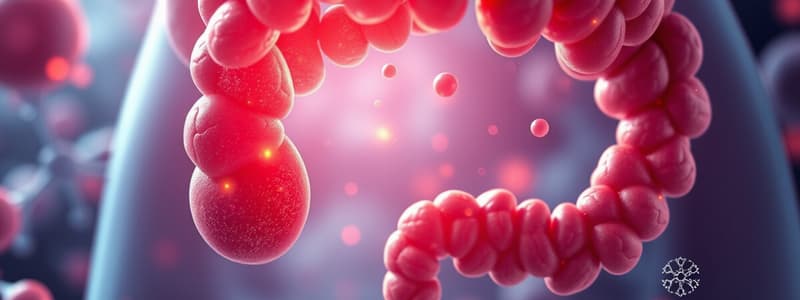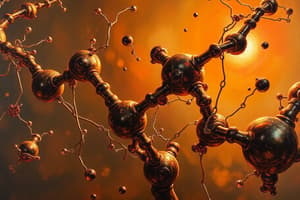Podcast
Questions and Answers
What is the typical half-life of short-lived proteins?
What is the typical half-life of short-lived proteins?
- Days to weeks
- Hours to days
- Minutes to hours (correct)
- Months to years
Which type of proteins are primarily associated with long half-lives?
Which type of proteins are primarily associated with long half-lives?
- Misfolded proteins
- Short-lived proteins
- Regulatory proteins
- Structural proteins (correct)
What is a characteristic of structural proteins with regards to their stability?
What is a characteristic of structural proteins with regards to their stability?
- They have short half-lives
- They cannot be synthesized de novo
- They are metabolically stable (correct)
- They are metabolically unstable
Which amino acid is mentioned in relation to the breakdown estimation of muscle proteins?
Which amino acid is mentioned in relation to the breakdown estimation of muscle proteins?
What is the significance of 3-methylhistidine in muscle protein breakdown?
What is the significance of 3-methylhistidine in muscle protein breakdown?
Which of the following describes a characteristic of misfolded proteins?
Which of the following describes a characteristic of misfolded proteins?
What effect does methylation have on muscle proteins after their incorporation into actomyosin?
What effect does methylation have on muscle proteins after their incorporation into actomyosin?
What type of proteins typically have a half-life of months to years?
What type of proteins typically have a half-life of months to years?
What occurs during transamination in amino acid catabolism?
What occurs during transamination in amino acid catabolism?
Which condition is characterized by increased plasma levels where ALT is less than AST?
Which condition is characterized by increased plasma levels where ALT is less than AST?
Where does oxidative deamination primarily occur within the cell?
Where does oxidative deamination primarily occur within the cell?
What is released as the result of oxidative deamination?
What is released as the result of oxidative deamination?
What role does nonhepatic disease play in the context of amino acids?
What role does nonhepatic disease play in the context of amino acids?
What role do aminopeptidases play in the digestion of oligopeptides?
What role do aminopeptidases play in the digestion of oligopeptides?
How are dipeptides and tripeptides further processed after absorption by intestinal epithelial cells?
How are dipeptides and tripeptides further processed after absorption by intestinal epithelial cells?
What happens to excessive amino acids in the body?
What happens to excessive amino acids in the body?
Why are proteins unable to be absorbed directly by the intestines?
Why are proteins unable to be absorbed directly by the intestines?
What pH level does gastric acid achieve, and how does this affect protein digestion?
What pH level does gastric acid achieve, and how does this affect protein digestion?
Which substances are primarily involved in amino acid and dipeptide absorption into intestinal epithelial cells?
Which substances are primarily involved in amino acid and dipeptide absorption into intestinal epithelial cells?
What is a consequence of diets high in protein regarding amino acid metabolism?
What is a consequence of diets high in protein regarding amino acid metabolism?
What are the primary organs involved in the production of proteolytic enzymes for protein digestion?
What are the primary organs involved in the production of proteolytic enzymes for protein digestion?
What role does glutamate play in the regeneration of ketoglutarate?
What role does glutamate play in the regeneration of ketoglutarate?
Which statement about coenzymes in glutamate dehydrogenase reactions is correct?
Which statement about coenzymes in glutamate dehydrogenase reactions is correct?
What activates glutamate dehydrogenase under low energy conditions?
What activates glutamate dehydrogenase under low energy conditions?
Which mechanism is primarily used by muscles for ammonia transport to the liver?
Which mechanism is primarily used by muscles for ammonia transport to the liver?
What inhibits the activity of glutamate dehydrogenase?
What inhibits the activity of glutamate dehydrogenase?
Which enzyme is responsible for oxidative deamination of D-amino acids?
Which enzyme is responsible for oxidative deamination of D-amino acids?
What is the primary cofactor involved in direct deamination by dehydratases?
What is the primary cofactor involved in direct deamination by dehydratases?
Which of the following conditions would favor the synthesis of ketoacids from glutamate?
Which of the following conditions would favor the synthesis of ketoacids from glutamate?
What is the effect of high energy molecules like GTP on the reversible reactions controlled by glutamate dehydrogenase?
What is the effect of high energy molecules like GTP on the reversible reactions controlled by glutamate dehydrogenase?
Which statement best describes the role of amino acid oxidases in amino acid deamination?
Which statement best describes the role of amino acid oxidases in amino acid deamination?
What is the primary function of pepsin in the digestive system?
What is the primary function of pepsin in the digestive system?
Which amino acids have the highest size of gradient during active transport?
Which amino acids have the highest size of gradient during active transport?
How is the contraluminal transport of amino acids characterized?
How is the contraluminal transport of amino acids characterized?
Which of the following is the COAL system responsible for transporting?
Which of the following is the COAL system responsible for transporting?
What is the energy source that drives active transport in the context of amino acid movement?
What is the energy source that drives active transport in the context of amino acid movement?
What is the role of pepsinogen in the stomach?
What is the role of pepsinogen in the stomach?
Which type of transport system is associated with Na+-dependent luminal transport?
Which type of transport system is associated with Na+-dependent luminal transport?
What is the major product of peptic hydrolysis of proteins?
What is the major product of peptic hydrolysis of proteins?
Flashcards are hidden until you start studying
Study Notes
Digestive Enzymes and Protein Stability
- Cytosolic proteins show varied reactivity based on amino acid terminal structure.
- Short-lived proteins, such as regulatory and misfolded proteins, have half-lives of minutes to hours.
- Long-lived proteins (e.g., most cellular proteins) have half-lives of days to weeks.
- Structural proteins, like collagen, are metabolically stable with half-lives of months to years.
- Muscle protein breakdown involves the release of 3-methylhistidine, which is excreted in urine.
Protein Digestion and Absorption
- Dietary proteins are too large for intestinal absorption; they must be hydrolyzed into amino acids.
- Proteolytic enzymes from the stomach, pancreas, and small intestines facilitate this process.
- Gastric juice (including hydrochloric acid and pepsin) denatures proteins and initiates digestion.
- Pepsin, an acid-stable endopeptidase, breaks down proteins into large polypeptides and free amino acids.
Enzymatic Digestion in the Small Intestine
- Aminopeptidases and dipeptidases at the intestinal lumen cleave amino acids from oligopeptides.
- Dipeptides and tripeptides are absorbed and further digested to free amino acids in intestinal epithelial cells.
- Free amino acids and dipeptides are transported to the liver via the portal system.
Amino Acid Transport Mechanisms
- Active transport systems, driven by ATP hydrolysis, pump amino acids into cells against a concentration gradient.
- A significant gradient exists for glutamate and glutamine uptake.
- The COAL system facilitates the uptake of cystine and dibasic amino acids (ornithine, arginine, lysine).
- Transport mechanisms include Na+-dependent (luminal) and Na+-independent (contraluminal) pathways.
Nitrogen Disposal and Amino Acid Catabolism
- Nonhepatic diseases lead to increased plasma levels of transaminases, indicative of tissue damage.
- Transamination transfers amino groups to glutamate, the first step in amino acid catabolism.
- Oxidative deamination liberates ammonia as a byproduct, primarily in the liver and kidneys.
- Glutamate dehydrogenase plays a key role in regenerating α-ketoglutarate and catalyzing oxidative deamination.
Role of Coenzymes and Regulators
- Oxidized forms of NAD (NAD+) and NADP (NADP+) serve as coenzymes in deamination reactions.
- The normal NADPH/NADP+ ratio in liver is high, supporting various metabolic pathways.
- Reaction direction relies on concentrations of glutamate, α-ketoglutarate, ammonia, and oxidized/reduced coenzyme ratios.
- Allosteric regulation of glutamate dehydrogenase occurs with ATP, GTP, and NADH acting as inhibitors, while ADP and GDP serve as activators.
Alternative Deamination Mechanisms
- L- and D-amino acid oxidases facilitate oxidative deamination, particularly in kidneys and liver.
- D-amino acid oxidase, a FAD-dependent enzyme, catalyzes the deamination of D-amino acids, creating ketoacids.
- Direct deamination can occur through dehydratases like serine and threonine dehydratases, utilizing pyridoxal phosphate.
Ammonia Transport to the Liver
- Two primary mechanisms transport ammonia to the liver:
- First Mechanism: Involves glutamine synthetase and glutaminase, prevalent in most tissues.
- Second Mechanism: Operates primarily in muscles and involves the transamination of pyruvate to alanine.
Studying That Suits You
Use AI to generate personalized quizzes and flashcards to suit your learning preferences.



